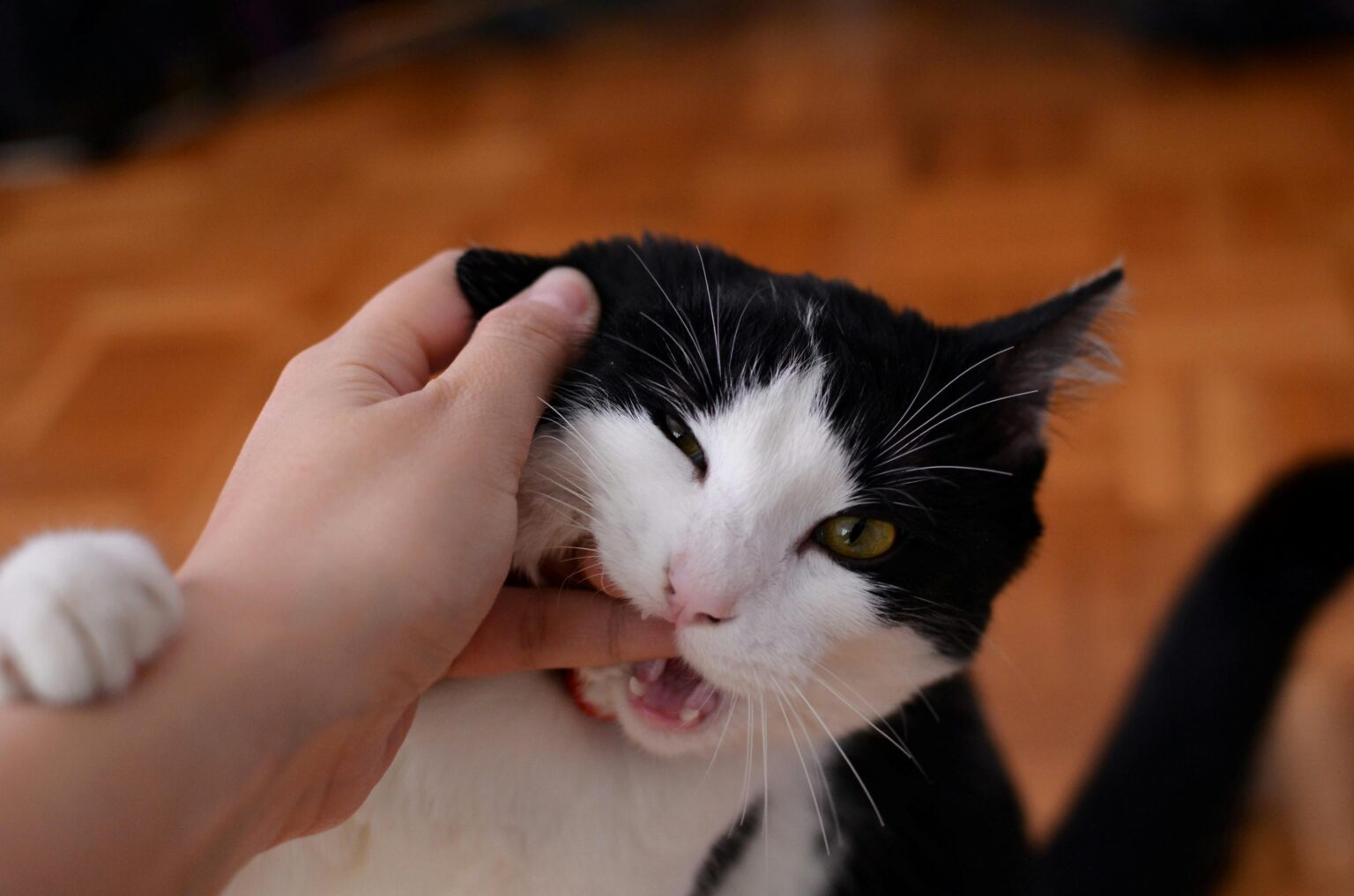Your cat bites your hand, then looks at you with those big marble eyes… mixed signals, right? Don’t worry. Hand-biting is common in cats, and with a little decoding (and a few smart tweaks), you can turn those nibbles into gentle, happy moments.
Why your cat bites your hand
Play practice (especially in kittens)
Cats are born hunters. Hands that wiggle like prey? Irresistible. Many kittens learn bite control through play, but if we use our hands as toys, they never learn where the line is.
Good news: this is one of the easiest behaviors to redirect. Think chase toys, wand toys, and anything that moves like prey.
Boredom or pent-up energy
A cat who doesn’t get enough mental or physical activity will make their own fun, and your hand might be part of the script. Daily play sessions, food puzzles, and climbing options often melt away “naughty” nibbles.
Curious to go deeper on feline motivations behind biting? You’ll love this clear breakdown of why cats bite.
Overstimulation during petting
Ever pet your cat, purrs galore… then suddenly a bite? That’s petting-induced overstimulation. It’s your cat saying, “Too much.” Watch for early signs: skin ripples, tail tip twitching, ears tilting back.
Short, gentle strokes in favorite areas (often cheeks and under the chin) help keep things sweet.
Pain, stress, or fear
Cats are stoic. A sudden bite when you touch a specific spot can signal discomfort or stress. If biting comes out of nowhere or escalates, a vet check is wise to rule out pain.
Decoding bite styles and body language
“Love bites”
Light, controlled nibbles during cuddle time? Those are often affection nibs. They shouldn’t break skin and usually come with soft eyes and relaxed whiskers.
Hard, sudden bites
A firm, fast bite can be fear, frustration, or a boundary being crossed. If eyes are wide, pupils dilated, ears back or tail puffed, your cat isn’t “being mean”—they’re overwhelmed.
Read the whole cat
Body language tells the story: ears (radar or flattened), whiskers (neutral or pushed forward), tail (gentle sway or whip). Understanding tail talk is especially helpful—see how to decode cat tail language.
What to do when your cat bites your hand
Your calm, immediate response
- Freeze your hand briefly, then slowly move it away.
- Stop the interaction or game for 30–60 seconds.
- Resume play using a toy, not your skin.
Common mistake to avoid: don’t pull your hand away fast or scold. Quick movement can trigger chase, and scolding creates stress—both make biting worse.
Redirect with a simple training plan
- Swap hands for toys: wand toys for chase, kickers for bunny kicks, and chew-safe toys for mouthing.
- Use short “hunt-play-eat-rest” sessions twice a day to drain energy.
- Reward calm behavior with treats or praise so your cat learns what earns attention.
Overwhelm or anxiety behind the biting? These signs of stress in cats will help you spot the triggers and soften them.
Soothing stress and fear
- Offer safe zones: a high shelf, a cozy hideaway, a quiet room.
- Keep routines steady—predictability lowers tension.
- Consider pheromone diffusers if your vet approves.
If the biting is sharp, frequent, or new, check for pain (mouth, joints, tummy). Medical discomfort often masquerades as “behavior.”
Prevention that really works
Daily enrichment menu
- Two structured play sessions (5–10 minutes each) using prey-like movement.
- Food puzzles or scatter-feeding for brain work.
- Vertical spaces and scratching posts to channel energy.
When you need extra safety strategies around intense moments, here’s how to handle an attacking cat kindly and effectively.
Consent-based petting
- Invite rather than insist: offer a hand, let your cat approach.
- Try the “5-second rule”: pet for a few seconds, pause, and see if they ask for more.
- Prefer cheeks and chin; avoid sensitive belly or tail base unless your cat clearly loves it.
Practical tip you’ll love: watch the tail tip during cuddles. If it starts to twitch like a metronome, stop petting, count to five, and offer a break or a toy. You’ll often prevent the bite before it happens.
Fun fact: cats often push their whiskers forward right before a pounce or bite—an adorable, tiny tell of “hunter mode.”
If your cat mouths objects too, this guide to feline chewing behavior can help you set up safe alternatives.
When to get extra help
Call your vet if biting is sudden, intense, or linked to touch in one area. A behaviorist can help tailor a plan if stress or fear is at play.
With patience, the right toys, and clear boundaries, those teeth will be busy where they belong—on toys, not on you.
FAQ
Is it normal if my cat gives me “love bites”?
Yes—gentle, controlled nibbles can be affectionate. They shouldn’t break skin and usually come with relaxed body language.
How do I stop my kitten from biting hands?
Never use hands as toys. Redirect to wand toys and kickers, pause play after bites, and reward calm play.
Could biting mean my cat is in pain?
It can. Sudden biting, sensitivity in one spot, or behavior changes deserve a vet check to rule out medical issues.
Should I punish my cat for biting?
No. Punishment increases fear and can escalate biting. Use calm pauses, redirection, and reward what you want instead.







